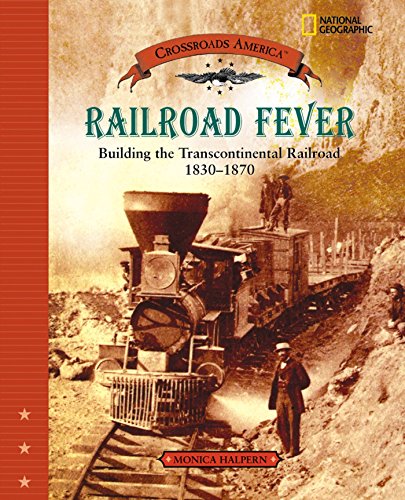All books / Book
Railroad Fever: Building the Transcontinental Railroad 1830 - 1870 (Crossroads America)

| Full title: | Railroad Fever: Building the Transcontinental Railroad 1830 - 1870 (Crossroads America) |
|---|---|
| ISBN: | 9780792269939 |
| ISBN 10: | 0792269934 |
| Authors: | |
| Publisher: | National Geographic Children's Books |
| Num. pages: | 40 |
| Binding: | Library Binding |
| Language: | en |
| Published on: | 2004 |
Read the reviews and/or buy it on Amazon.com
Synopsis
by The 1840s, Daring Americans Were Trickling Westward To Begin A New Life In The Great Wide Open. When Gold Was Discovered In 1848, The Promise Of Riches Drew People By The Thousands Out To California. But The Journey Was Slow And Dangerous, Since The Best Ways Of Travelling Were By Wagon And On Foot.during The Railroad Fever Of The 1830s, Thousands Of Miles Of Track Were Laid, Mostly Throughout The Northeast And The South. Few Had Dreamt Of Extending This New Travel Westward-but All It Takes Is A Few. Abraham Lincoln Signed The Pacific Railroad Act In 1862, Allowing For The Start Of The First Transcontinental Railroad.though Construction Problems And Hard Times Confronted Them, American Workers, Chinese Immigrants, And Former Slaves Pounded Away Through The Rough Geography Of The Western U.s., Paving A Path For The New Train.a Day In The Life Of A Railroad Worker Was Not An Easy One. The Work Was Backbreaking; The Conditions Were Terrible; And Workers Were Often Faced With Attack From Native Americans. The Building Of The Railroad Turned Into A Great Race Between Two Companies, The Central Pacific And The Union Pacific, To See Who Could Finish Their Part Of The Railroad Faster. The Company That Got Farthest Stood To Make The Most Money. The Great Race Turned Into A National Pastime-with Reports Of Progress Dominating The News.railroad Fever Illuminates The Struggles Of The Railroad Worker, The Anger Of The Plains Indians, And The Many Changes In Both American Life And Geography That Were Prompted By The Railroad. The Completion Of The Transcontinental Railroad Left Empty Boomtowns Across The Country, Changed The Ethnic Face Of America, And, Of Course, Created A New Exciting Andfast Way Of Travel.like The Other Titles In The Crossroads America Series, Railroad Fever Is Illustrated With Period Paintings, Drawings, And Photographs. Also Included Are A Glossary And An Index.
susan Hepler, Ph.d. - Children's Literature
this Entry In The Crossroads America Series Begins With A Short Introduction Of Steam Trains And The Changes They Wrought In Transportation, The Need For Track, And People's Sending Of Goods. Much Of The Book Is Given Over To The Big Four, As Collis Huntington, Leland Stanford, Mark Hopkins, And Charles Crocker Were Called, And Their Planning And Development Of The Union Pacific Line. One Short Chapter Presents The Workers, Including A Typical Day, A Work Train, Role Of The Chinese, Threats From Native Americans, And The Famous Race. In 1966, The Government Approved A Race Between The Central Pacific And The Union Pacific, Moving Toward Each Other With The One That Laid The Most Track Making The Most Money. Interestingly, The Track Was Finished Seven Years Ahead Of Schedule. A Fascinating End Chapter Details Who Rode The Train, A Sidebar Mentions Jesse James, First Class And Immigrant Travel Are Compared, And The Summary Suggests What Changes This Cross-country Railroad Wrought. Photographs, Tinted Etchings, Primary Source Material, Maps, Boxed Short Quotes, And The Occasional Sidebar Contribute To This Well-designed Book. It's A Fine Addition To The Series And One That Would Serve Middle-school Readers Studying American History As Well Provide Supplemental Reading For An Average Reader In A High School Course. 2004, National Geographic, Ages 10 To 14.